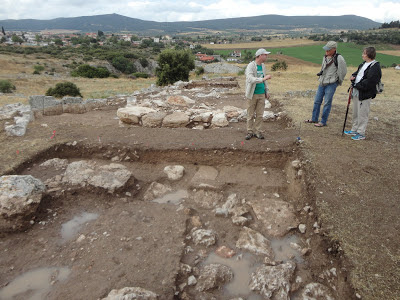Last weekend was the international conference entitled “Communities in Transition. The Circum-Aegean Later Neolithic Stages” held at the New Akropolis Museum’s overly air-conditioned auditorium. This well-organized and well-attended gathering was ambitious in its scope and inclusive in the papers given. Zarko Tankosic (Norwegian Institute) discussed the peculiar exploitation pattern of the Karystian Kampos in the Neolithic period as revealed by the
Southern Euboea Exploration Project survey there. The Institute was represented by Tristan Carter (Department of Anthropology, McMaster University) who explored the potential off-island sources for various prominent cultural features of the later Neolithic in Crete. In the same session was a paper on the Neolithic pottery from
the site of Kiapha Thiti (also known as Kontra Gliate) in southern Attika that a team led by Dietmar Hagel (Queen's University) excavated in the 1980s. A Ph.D. candidate at University College London, Margarita Nazou, gave this interesting paper.
On a final note, not only were there the usual show and tell presentations, which have value in enlightening one on material little or unknown to the audience, but also a number of synthetic, thought-provoking papers. Krzysztof Nowicki (Warsaw) proposed that the settlement system seen in eastern Crete during the Bronze Age was established with the arrival of immigrants during the Final Neolithic II period. Miljana Radivojevic (University College London) gave one of the best powerpoint presentations and deliveries that I have heard in a very long time. She made a strong case for one of the core regions for the origins and development of copper, bronze, gold and silver metallurgy being western Bulgaria in the 5th millennium BC.
 |
| Visiting the Institute's excavations at Eleon |
Yesterday, braving the unusually stormy weather for mid-June in southern Greece, I visited the
Eastern Boeotia Archaeological Project excavations at the
acropolis of Eleon. Gerry Schaus, Loeta Tyree and my dear wife Metaxia Tsipopoulou joined me for this muddy expedition. It has been a year since my last visit and the impression of the architectural remains has changed dramatically under the expert direction in the field by Brendan Burke (University of Victoria) and Bryan Burns (Wellesley College)! The original two 5 x 5 m trenches located on the inside of the line of the polygonal wall now are at least 10 x 10 m in extent. The LH IIIC early remains are substantial in both of them. The earlier LH IIIB remains show great promise to produce evidence for large structures. There is also more evidence for later activity including cultic material as well as refuse pits. What really catches one’s eye is the zig-zagging entrance ramp to what now appears to be a gate at the northern end of the visible wall. The elements used, large tower, polygonal masonry and the remnants of the Late Bronze Age wall, create an enclosed theatral-like area before the gate. Here too various types of terracotta female figurines, miniature vessels and lamps were found. Some type of shrine must have been in the area. The excavation holds much promise for significant discoveries this year and in the future.
 |
| View of the excavation area at the sanctuary of Apollo at Abai |
Our next destination was the famous oracular sanctuary of Apollo Abaeus associated with ancient Abai near modern Kalopodi (Phthiotides). The site was first investigated from 1972-1983 by the German Archaeological Institute in Athens. Since 2004 there have been renewed excavations under the direction of Wolf-Dietrich Niemeier. Alas, the heavy rain on Wednesday and again on Thursday cancelled the work at the site so we could only view the covered remains from afar in the gentle mist. Undeterred we set off to find ancient Hyampolis to the south. The circular hill that is the akropolis has evidence of polygonal walls and a gate. Since it was raining harder we returned to the town of Atalanti to visit the excellent archaeological museum there that features the finds from a number of important Neolithic and LH IIIB and C sites. This is worth a detour from the nearby Athens/Thessaloniki National Road to see.
I will be spending the summer in Crete digging at Petras and at Halasmenos as well as working on the Winter Colloquium publication. From time to time I will blog concerning my experiences and observations. In addition, we will have a series of guest bloggers to provide more interesting fare. See you in September……………………………..….!
Kalo Kalokairi,
David Rupp
Director



No comments:
Post a Comment